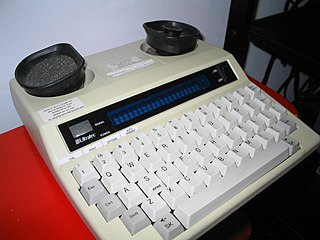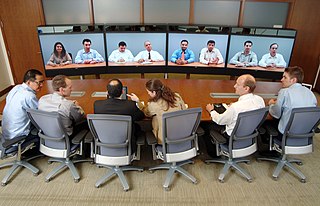
Closed captioning (CC) is a form of subtitling, a process of displaying text on a television, video screen, or other visual display to provide additional or interpretive information, where the viewer is given the choice of whether the text is displayed. Closed captions are typically used as a transcription of the audio portion of a program as it occurs, sometimes including descriptions of non-speech elements. Other uses have included providing a textual alternative language translation of a presentation's primary audio language that is usually burned-in to the video and unselectable.

A telecommunications device for the deaf (TDD) is a teleprinter, an electronic device for text communication over a telephone line, that is designed for use by persons with hearing or speech difficulties. Other names for the device include teletypewriter (TTY), textphone, and minicom.
Communication access realtime translation (CART), also called open captioning or realtime stenography or simply realtime captioning, is the general name of the system that stenographers and others use to convert speech to text. A trained operator writes the exact words spoken using a special phonetic keyboard, or stenography methods, relaying a reliable and accurate translation that is broadcast to the recipient on a screen, laptop, or other device. CART professionals have qualifications for added expertise (speed and accuracy) as compared to court reporters and other stenographers.

A telecommunications relay service, also known as TRS, relay service, or IP-relay, or Web-based relay service, is an operator service that allows people who are deaf, hard of hearing, deafblind, or have a speech disorder to place calls to standard telephone users via a keyboard or assistive device. Originally, relay services were designed to be connected through a TDD, teletypewriter (TTY) or other assistive telephone device. Services gradually have expanded to include almost any real-time text capable technology such as a personal computer, laptop, mobile phone, PDA, and many other devices. The first TTY was invented by deaf scientist Robert Weitbrecht in 1964. The first relay service was established in 1974 by Converse Communications of Connecticut.

Deaf culture is the set of social beliefs, behaviors, art, literary traditions, history, values, and shared institutions of communities that are influenced by deafness and which use sign languages as the main means of communication. When used as a cultural label, especially within the culture, the word deaf is often written with a capital D and referred to as "big D Deaf" in speech and sign. When used as a label for the audiological condition, it is written with a lower case d. Carl G. Croneberg was among the first to discuss analogies between Deaf and hearing cultures in his appendices C and D of the 1965 Dictionary of American Sign Language.

Videotelephony is the use of audio and video for simultaneous two-way communication. Today, videotelephony is widespread. There are many terms to refer to videotelephony. Videophones are standalone devices for video calling. In the present day, devices like smartphones and computers are capable of video calling, reducing the demand for separate videophones. Videoconferencing implies group communication. Videoconferencing is used in telepresence, whose goal is to create the illusion that remote participants are in the same room.

A video relay service (VRS), also sometimes known as a video interpreting service (VIS), is a video telecommunication service that allows deaf, hard-of-hearing, and speech-impaired (D-HOH-SI) individuals to communicate over video telephones and similar technologies with hearing people in real-time, via a sign language interpreter.
Within the field of human–computer interaction, accessibility of video games is considered a sub-field of computer accessibility, which studies how software and computers can be made accessible to users with various types of impairments. It can also include tabletop RPGs, board games, and related products.
Text over IP is a means of providing a real-time text (RTT) service that operates over IP-based networks. It complements Voice over IP (VoIP) and Video over IP.

Video remote interpreting (VRI) is a videotelecommunication service that uses devices such as web cameras or videophones to provide sign language or spoken language interpreting services. This is done through a remote or offsite interpreter, in order to communicate with persons with whom there is a communication barrier. It is similar to a slightly different technology called video relay service, where the parties are each located in different places. VRI is a type of telecommunications relay service (TRS) that is not regulated by the FCC.
Telephone interpreting connects human interpreters via telephone to individuals who wish to speak to each other but do not share a common language. The telephone interpreter converts the spoken language from one language to another, enabling listeners and speakers to understand each other. Interpretation over the telephone most often takes place in consecutive mode, which means that the interpreter waits until the speaker finishes an utterance before rendering the interpretation into the other language. As the use of the telephonic modality is increasing it is allowing users to access an interpreter immediately, regardless of time and location.
Next Generation 911 refers to an initiative aimed at updating the 911 service infrastructure in the United States and Canada to improve public emergency communications services in a growing wireless mobile society. In addition to calling 911 from a phone, it intends to enable the public to transmit text, images, video and data to the 911 center. The initiative also envisions additional types of emergency communications and data transfer. This NG911 infrastructure is intended to replace the current services over time. The National Emergency Number Association (NENA) first identified the need for NG911 in 2000, and started development actions in 2003, and is nearing full definition and standards for NG911. Since 2006, the US Department of Transportation (DOT) in the United States and the Canadian Radio-television and Telecommunications Commission (CRTC) in Canada have been leading their respective initiatives, which include research and development projects aimed at advancing NG911. On January 24, 2013, the CRTC announced the first step toward a Canadian implementation of NG911 and, in March 2016, began a consultation with the public to discuss what services should be offered, who will play a role in offering these services and how these services should be paid for. Several US states have implemented versions of NG911, as of October 2013.
An organic minute is defined as the natural state of which telecommunications relay calls are processed between caller and called parties through Communications Assistant that are in conversation mode; that is, no incentives to encourage unnecessary relay minutes.
Real-time text (RTT) is text transmitted instantly as it is typed or created. Recipients can immediately read the message while it is being written, without waiting.
Total conversation is an ITU standard of simultaneous video, voice and text service in telecommunications. Total conversation allows people in two or more locations to: (a) see each other, (b) hear each other, and (c) conduct a text interaction with each other, or choose to communicate with any combination of those three modes and to do so in real-time.
Accessibility apps are mobile apps that increase the accessibility of a device or technology for individuals with disabilities. Applications, also known as, application software, are programs that are designed for end users to be able to perform specific tasks. There are many different types of apps, some examples include, word processors, web browsers, media players, console games, photo editors, accounting applications and flight simulators. Accessibility generally refers to the design of products and environments to be usable by people with disabilities. Accessibility apps can also include making a current version of software or hardware more accessible by adding features. Accessibility apps aim to reduce barriers to technological goods and services, making them more usable for various groups within society. A basic example is that a person who experiences vision impairments is able to access technology through enabling voice recognition and text-to-speech software.

The Twenty-First Century Communications and Video Accessibility Act of 2010 (CVAA) is a United States accessibility law. Signed on October 8, 2010, by then-president Barack Obama, the bill amended the Communications Act of 1934 to include updated requirements for ensuring the accessibility of "modern" telecommunications to people with disabilities.
Treatment depends on the specific cause if known as well as the extent, type, and configuration of the hearing loss. Most hearing loss results from age and noise, is progressive, and irreversible. There are currently no approved or recommended treatments to restore hearing; it is commonly managed through using hearing aids. A few specific types of hearing loss are amenable to surgical treatment. In other cases, treatment involves addressing underlying pathologies, but any hearing loss incurred may be permanent.
Japanese Sign Language (JSL), also known as Nihon Shuwa, is the unofficial but most predominantly used sign language used by nearly 57,000 native signers as their primary language. It is a convergent, Deaf community sign language developed in the late 19th century.
The Canadian Association of the Deaf estimates that there are over 350,000 Deaf Canadians, but there is not an exact number since there has never been a formal census on Deaf Canadians. There are approximately 1.2 million Indigenous people and over 750 reserves in Canada. There are various intersections of deaf and Indigenous culture, including valuing community, rooting their identity in their culture and its associated group instead of their individuality, having their identities oversimplified, being underrepresented in research and data collection, and experiencing health inequities due to their identities. There is limited research on Deaf Indigenous people, but the Saskatchewan Human Rights Association argues that issues faced by Deaf people are exacerbated when that person is also Indigenous.






